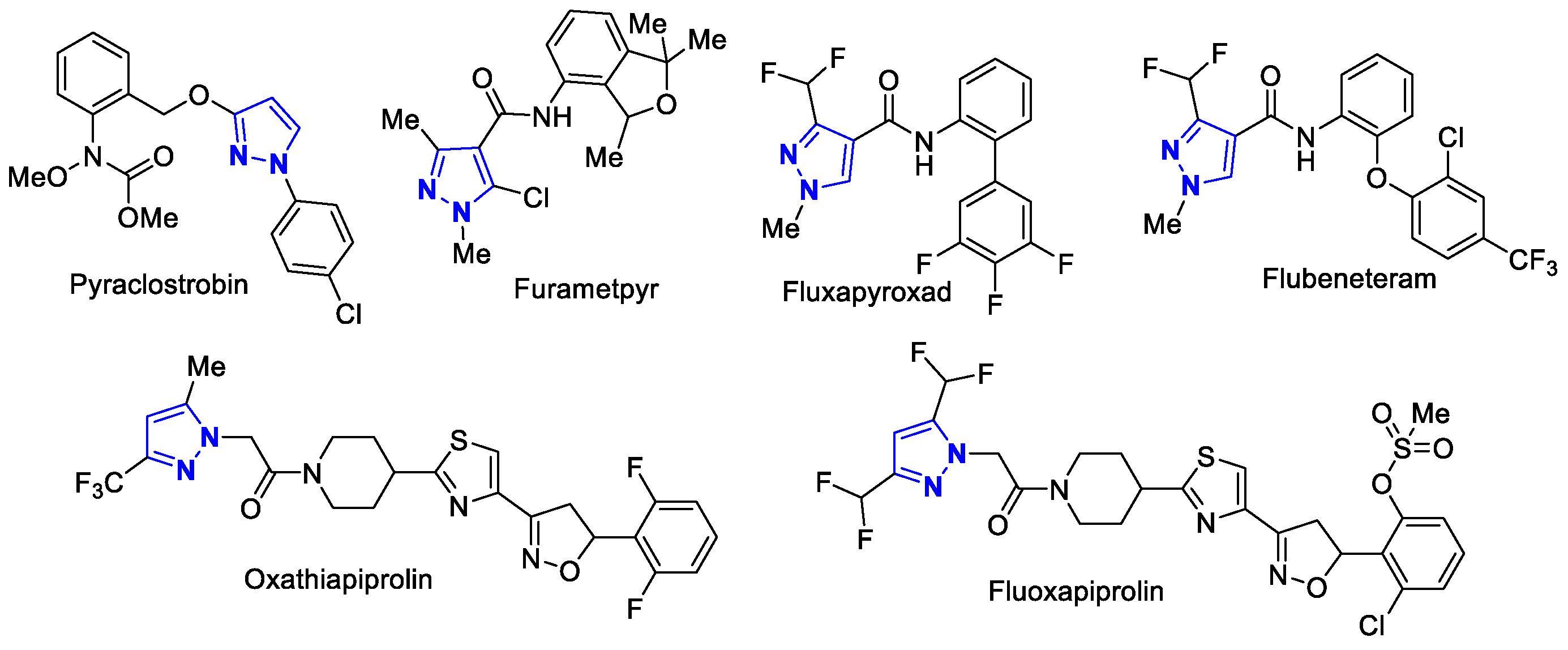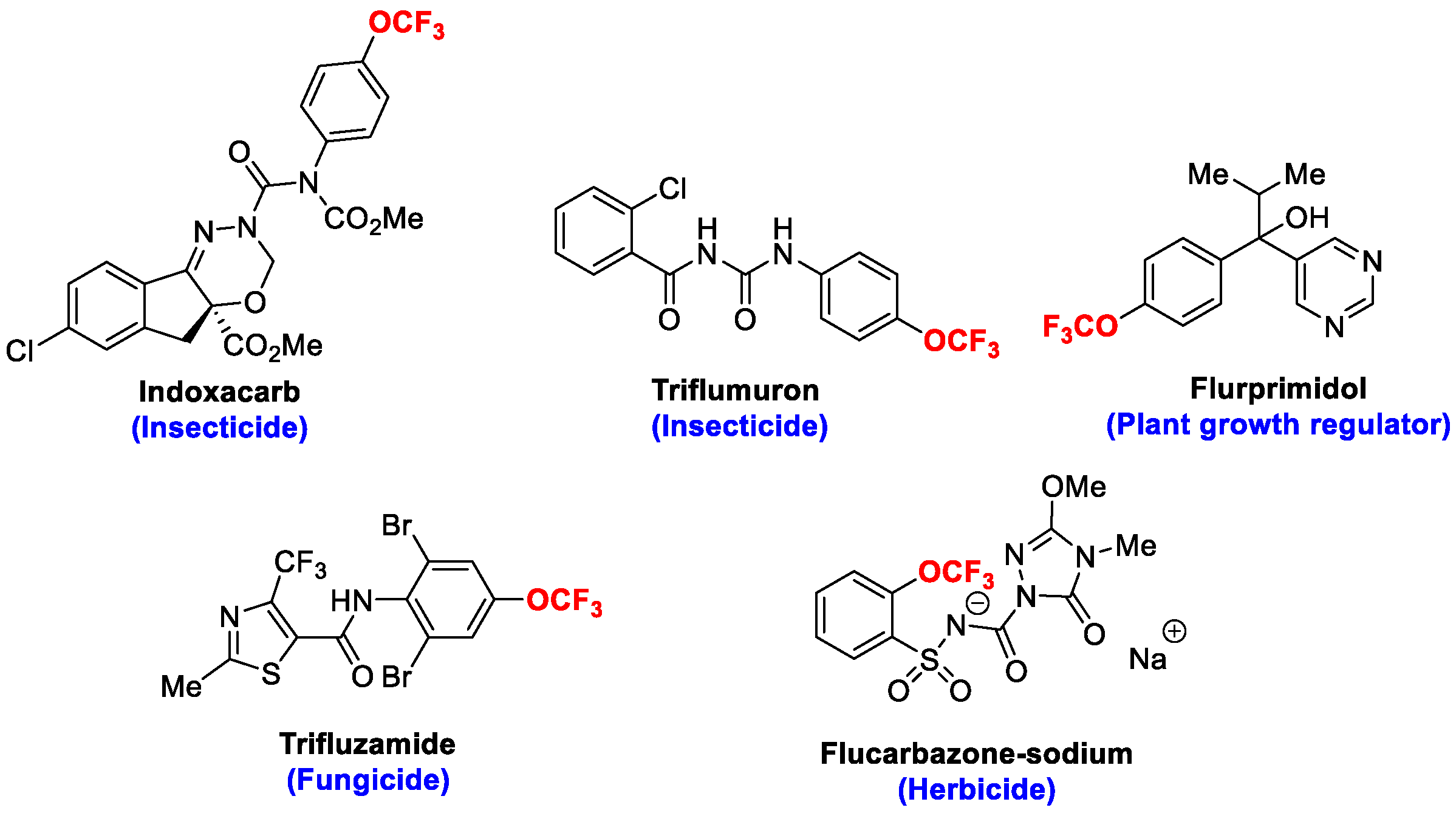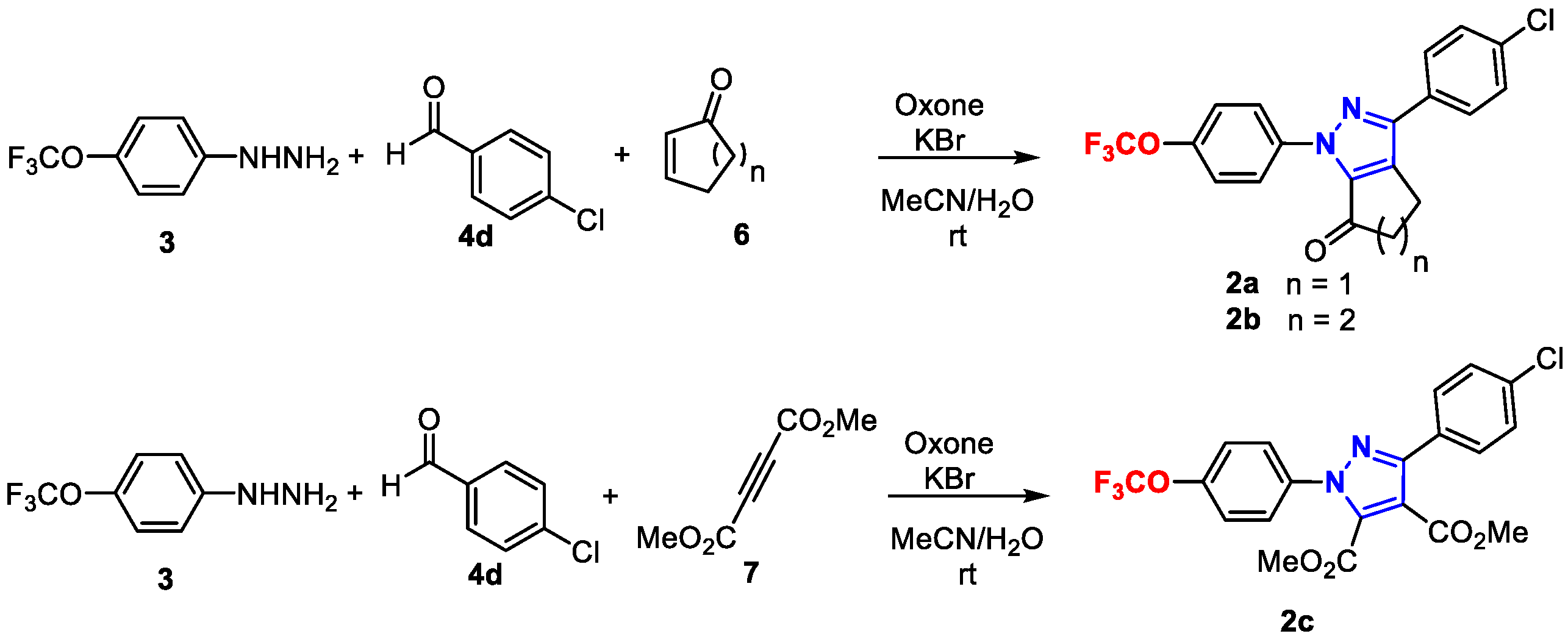Design, Synthesis and Antifungal Activities of Novel Pyrazole Analogues Containing the Aryl Trifluoromethoxy Group
Abstract
:1. Introduction
2. Results
2.1. Chemistry
2.2. In Vitro Antifungal Activity
3. Discussion
4. Materials and Methods
4.1. General Information
4.2. Synthetic Procedures
4.3. Bioassays
5. Conclusions
Supplementary Materials
Author Contributions
Funding
Institutional Review Board Statement
Informed Consent Statement
Data Availability Statement
Acknowledgments
Conflicts of Interest
Sample Availability
References
- Li, L.; Zhu, X.-M.; Zhang, Y.-R.; Cai, Y.-Y.; Wang, J.-Y.; Liu, M.-Y.; Wang, J.-Y.; Bao, J.-D.; Lin, F.-C. Research on the molecular interaction mechanism between plants and pathogenic fungi. Int. J. Mol. Sci. 2022, 23, 4658. [Google Scholar] [CrossRef]
- Strange, R.N.; Scott, P.R. Plant disease: A threat to global food security. Annu. Rev. Phytopathol. 2005, 43, 83–116. [Google Scholar] [CrossRef]
- Brase, S.; Encinas, A.; Keck, J.; Nising, C.F. Chemistry and biology of mycotoxins and related fungal metabolites. Chem. Rev. 2009, 109, 3903–3990. [Google Scholar] [CrossRef] [PubMed]
- Steinberg, G.; Gurr, S.J. Fungi, Fungicide discovery and global food security. Fungal Genet. Biol. 2020, 144, 103476. [Google Scholar] [CrossRef]
- Jeschke, P. Progress of modern agricultural chemistry and future prospects. Pest Manag. Sci. 2016, 72, 433–455. [Google Scholar] [CrossRef] [PubMed]
- Ivanov, M.; Ćirić, A.; Stojković, D. Emerging antifungal targets and strategies. Int. J. Mol. Sci. 2022, 23, 2756. [Google Scholar] [CrossRef]
- Fisher, M.C.; Hawkins, N.J.; Sanglard, D.; Gurr, S.J. Worldwide emergence of resistance to antifungal drugs challenges human health and food security. Science 2018, 360, 739–742. [Google Scholar] [CrossRef] [PubMed]
- Sierotzki, H.; Scalliet, G. A Review of Current Knowledge of Resistance Aspects for the Next-Generation Succinate Dehydrogenase Inhibitor Fungicides. Phytopathology 2013, 103, 880–887. [Google Scholar] [CrossRef]
- Mykhailiuk, P.K. Fluorinated Pyrazoles: From Synthesis to Applications. Chem. Rev. 2021, 121, 1670–1715. [Google Scholar] [CrossRef]
- Zhang, Z.-T.; Tan, D.-J.; Xue, D. A Concise One-Pot Synthesis of 3,4-Diaryl-1H-pyrazoles from Natural Isoflavones and Hydrazine Hydrate. Helv. Chim. Acta 2007, 90, 2096–2108. [Google Scholar] [CrossRef]
- Zhang, J.; Peng, J.-F.; Wang, T.; Kang, Y.; Jing, S.-S.; Zhang, Z.-T. Synthesis and biological evaluation of arylpyrazoles as fungicides against phytopathogenic fungi. Mol. Divers. 2017, 21, 317–323. [Google Scholar] [CrossRef]
- Zhang, J.; Tan, D.-J.; Wang, T.; Jing, S.-S.; Kang, Y.; Zhang, Z.-T. Synthesis, crystal structure, characterization and antifungal activity of 3,4-diaryl-1H-Pyrazoles derivatives. J. Mol. Struct. 2017, 1149, 235–242. [Google Scholar] [CrossRef]
- Mert, S.; Kasımoğulları, R.; İça, T.; Çolak, F.; Altun, A.; Ok, S. Synthesis, structure-activity relationships, and in vitro antibacterial and antifungal activity evaluations of novel pyrazole carboxylic and dicarboxylic acid derivatives. Eur. J. Med. Chem. 2014, 78, 86–96. [Google Scholar] [CrossRef]
- Faria, J.V.; Vegi, P.F.; Miguita, A.G.C.; dos Santos, M.S.; Boechat, N.; Bernardino, A.M.R. Recently reported biological activities of pyrazole compounds. Bioorg. Med. Chem. 2017, 25, 5891–5903. [Google Scholar] [CrossRef]
- Lamberth, C. Pyrazole chemistry in crop protection. Heterocycles 2007, 71, 1467–1502. [Google Scholar] [CrossRef]
- Luo, B.; Ning, Y. Comprehensive Overview of Carboxamide Derivatives as Succinate Dehydrogenase Inhibitors. J. Agric. Food Chem. 2022, 70, 957–975. [Google Scholar] [CrossRef] [PubMed]
- Ebenezer, O.; Shapi, M.; Tuszynski, J.A. A Review of the Recent Devepopment in the Synthesis and Biological Evaluations of Pyrazole Drivatives. Biomedcines 2022, 10, 1124. [Google Scholar] [CrossRef] [PubMed]
- Sauter, H.; Steglich, W.; Anke, T. Strobilurins: Evolution of a New Class of Active Substances. Angew. Chem. Int. Ed. 1999, 38, 1328–1349. [Google Scholar] [CrossRef]
- Li, S.Q.; Li, X.S.; Zhang, H.M.; Wang, Z.S.; Xu, H.L. The research progress in and perspective of potential fungicides: Succinate dehydrogenase inhibitors. Bioorg. Med. Chem. 2021, 50, 116476. [Google Scholar] [CrossRef] [PubMed]
- Miao, J.Q.; Dong, X.; Lin, D.; Wang, Q.; Liu, P.; Chen, F.; Du, Y.; Liu, X. Activity of the novel fungicide oxathiapiprolin against plant-pathogenic oomycetes. Pest Manag. Sci. 2016, 72, 1572–1577. [Google Scholar] [CrossRef]
- Si, Y.; Tang, P. Development and Application of Trifluoromethoxylating Reagents. Chin. J. Chem. 2023, 41, 2179–2196. [Google Scholar] [CrossRef]
- Federsel, D.; Herrmann, A.; Christen, D.; Sander, S.; Willner, H.; Oberhammer, H. Structure and conformation of α,α,α-trifluoroanisol, C6H5OCF3. J. Mol. Struct. 2001, 567–568, 127–136. [Google Scholar] [CrossRef]
- Müller, K.; Faeh, C.; Diederich, F. Fluorine in pharmaceuticals: Looking beyond intuition. Science 2007, 317, 1881–1886. [Google Scholar] [CrossRef]
- Chen, Y.; Zhang, A.F.; Wang, W.X.; Zhang, Y.; Gao, T.C. Baseline sensitivity and efficacy of thifluzamide in Rhizoctonia solani. Ann. Appl. Biol. 2012, 161, 247–254. [Google Scholar] [CrossRef]
- Howard, J.; Wall, R. The effects of triflumuron, a chitin synthesis inhibitor, on the housefly, Musca domestica (Diptera: Muscidae). Bull. Entomol. Res. 1995, 85, 71–77. [Google Scholar] [CrossRef]
- Manteau, B.; Pazenok, S.; Vors, J.-P.; Leroux, F.R. New trends in the chemistry of α-fluorinated ethers, thioehters, amines and phosphines. J. Fluor. Chem. 2010, 131, 140–158. [Google Scholar] [CrossRef]
- Song, L.; Lai, Y.; Li, H.; Ding, J.; Yao, H.; Su, Q.; Huang, B.; Ouyang, M.-A.; Tong, R. Environmentally Begign and User-Friendly In Situ Generation of Nitrile Imines from Hydrazones for 1,3-Dipolar Cycloaddition. J. Org. Chem. 2022, 87, 10550–10554. [Google Scholar] [CrossRef]
- Xu, H.; Sun, Y.; Li, H.; Lai, Y.; Zhao, T.; Meng, Y.; Pan, X.; Lin, R.; Song, L. Design, synthesis and antifungal activities of novel cis-enamides via intermediate derivatization method. Adv. Agrochem 2023, 2, 97–103. [Google Scholar] [CrossRef]
- Xu, H.; Chen, T.; Huang, L.; Shen, Q.; Lian, Z.; Shi, Y.; Ouyang, M.-A.; Song, L. Synthesis and Fungicidal Activity of Lansiumamide A and B and Their Derivatives. Molecules 2018, 23, 1499. [Google Scholar] [CrossRef] [PubMed]





| Compounds | Average Inhibition Rate ± SD (%) (n = 3) | |||||
|---|---|---|---|---|---|---|
| No. | B. cinerea | M. oryzae | P. aphanidermatum | F. graminearum | C. micotianae | V. mali |
| 1a | 5.74 ± 1.13 | 2.78 ± 1.04 | 5.81 ± 2.83 | 9.65 ± 0.93 | 2.45 ± 1.52 | 9.59 ± 0.96 |
| 1b | 7.23 ± 0.68 | 1.44 ± 1.20 | 10.47 ± 2.64 | 17.05 ± 3.38 | 8.48 ± 0.80 | 3.99 ± 2.94 |
| 1c | 4.80 ± 0.97 | 0.97 ± 1.32 | 5.65 ± 1.05 | 25.61 ± 1.20 | 0.61 ± 2.38 | 0.97 ± 1.60 |
| 1d | 4.80 ± 0.58 | 4.34 ± 0.95 | 9.84 ± 0.93 | 1.71 ± 0.59 | 0.41 ± 0.65 | 2.42 ± 0.84 |
| 1e | 13.89 ± 0.76 | 8.73 ± 1.26 | 13.27 ± 1.06 | 17.71 ± 2.06 | 13.34 ± 5.08 | 16.64 ± 1.24 |
| 1f | 22.32 ± 1.31 | 4.27 ± 1.30 | 5.39 ± 3.35 | 3.05 ± 0.71 | 7.51 ± 0.80 | 6.06 ± 0.68 |
| 1g | 1.16 ± 0.61 | 12.00 ± 3.52 | 8.56 ± 0.84 | 20.41 ± 0.68 | 10.60 ± 1.20 | 3.79 ± 0.62 |
| 1h | 5.25 ± 3.38 | 5.56 ± 1.55 | 3.63 ± 0.84 | 17.95 ± 7.95 | 0 | 4.92 ± 3.34 |
| 1i | 11.52 ± 0.88 | 5.27 ± 1.29 | 4.80 ± 1.01 | 0.44 ± 0.72 | 0 | 6.08 ± 2.82 |
| 1j | 9.59 ± 2.97 | 2.15 ± 0.94 | 1.25 ± 1.27 | 0.96 ± 1.02 | 0.41 ± 3.64 | 9.27 ± 1.60 |
| 1k | 30.30 ± 0.67 | 24.24 ± 1.27 | 26.33 ± 0.59 | 18.43 ± 4.92 | 34.4 ± 0.82 | 24.92 ± 0.60 |
| 1l | 3.78 ± 0.47 | 6.37 ± 1.04 | 11.42 ± 0.79 | 9.14 ± 1.28 | 7.70 ± 0.91 | 3.03 ± 1.21 |
| 1m | 8.20 ± 1.21 | 4.64 ± 0.68 | 5.77 ± 1.10 | 21.36 ± 0.86 | 5.67 ± 1.65 | 4.59 ± 0.59 |
| 1n | 2.88 ± 0.45 | 0 | 8.55 ± 1.17 | 6.08 ± 3.38 | 1.79 ± 1.21 | 4.88 ± 0.94 |
| 1o | 5.25 ± 0.80 | 0 | 9.07 ± 3.73 | 0 | 0 | 9.35 ± 1.27 |
| 1p | 31.29 ± 3.01 | 23.09 ± 0.77 | 27.24 ± 1.47 | 39.75 ± 0.92 | 33.05 ± 0.64 | 21.81 ± 0.98 |
| 1q | 13.86 ± 0.59 | 9.24 ± 0.58 | 13.72 ± 8.08 | 33.19 ± 2.83 | 14.28 ± 0.64 | 3.39 ± 0.47 |
| 1r | 4.15 ± 0.99 | 3.54 ± 2.85 | 3.83 ± 4.20 | 20.85 ± 1.18 | 15.24 ± 1.30 | 8.26 ± 1.32 |
| 1s | 6.32 ± 3.95 | 6.37 ± 4.76 | 2.70 ± 0.82 | 16.38 ± 0.71 | 10.8 ± 0.72 | 0 |
| 1t | 29.18 ± 1.34 | 40.06 ± 0.68 | 29.82 ± 0.74 | 65.11 ± 0.61 | 47.56 ± 4.43 | 28.14 ± 0.62 |
| 1u | 7.91 ± 1.35 | 5.96 ± 0.71 | 4.48 ± 0.57 | 18.83 ± 0.53 | 18.54 ± 2.54 | 8.80 ± 2.28 |
| 1v | 37.61 ± 3.33 | 35.33 ± 0.62 | 38.51 ± 1.31 | 81.22 ± 0.60 | 56.03 ± 0.80 | 41.22 ± 0.65 |
| 1w | 13.70 ± 0.83 | 11.59 ± 0.77 | 15.23 ± 0.59 | 7.79 ± 0.78 | 12.93 ± 4.26 | 6.73 ± 0.96 |
| 2a | 26.55 ± 2.07 | 23.27 ± 0.96 | 22.42 ± 1.08 | 45.54 ± 4.62 | 36.81 ± 5.90 | 23.57 ± 0.44 |
| 2b | 13.57 ± 0.87 | 14.88 ± 2.41 | 14.03 ± 1.13 | 43.83 ± 3.90 | 40.39 ± 2.46 | 20.39 ± 1.61 |
| 2c | 16.92 ± 0.88 | 16.64 ± 0.45 | 10.63 ± 1.10 | 32.04 ± 0.86 | 46.01 ± 1.08 | 15.41 ± 3.21 |
| Pyraclostrobin | 77.57 ± 0.93 | 77.53 ± 0.62 | 75.57 ± 0.59 | 80.14 ± 1.16 | 69.62 ± 0.61 | 74.38 ± 0.72 |
| Compounds | EC50 (95% CI *) | EC50 (95% CI *) | |
|---|---|---|---|
| No. | R | F. graminearum | C. micotianae |
| 1v | cyclohexyl | 0.0530 (0.0409–0.0669) | 0.1430 (0.1152–0.1953) |
| 1t | n-propyl | 0.0735 (0.0506–0.1053) | - |
| Pyraclostrobin | 0.0112 (0.0026–0.0211) | 0.0352 (0.0165–0.0551) | |
Disclaimer/Publisher’s Note: The statements, opinions and data contained in all publications are solely those of the individual author(s) and contributor(s) and not of MDPI and/or the editor(s). MDPI and/or the editor(s) disclaim responsibility for any injury to people or property resulting from any ideas, methods, instructions or products referred to in the content. |
© 2023 by the authors. Licensee MDPI, Basel, Switzerland. This article is an open access article distributed under the terms and conditions of the Creative Commons Attribution (CC BY) license (https://creativecommons.org/licenses/by/4.0/).
Share and Cite
Zhao, T.; Sun, Y.; Meng, Y.; Liu, L.; Dai, J.; Yan, G.; Pan, X.; Guan, X.; Song, L.; Lin, R. Design, Synthesis and Antifungal Activities of Novel Pyrazole Analogues Containing the Aryl Trifluoromethoxy Group. Molecules 2023, 28, 6279. https://doi.org/10.3390/molecules28176279
Zhao T, Sun Y, Meng Y, Liu L, Dai J, Yan G, Pan X, Guan X, Song L, Lin R. Design, Synthesis and Antifungal Activities of Novel Pyrazole Analogues Containing the Aryl Trifluoromethoxy Group. Molecules. 2023; 28(17):6279. https://doi.org/10.3390/molecules28176279
Chicago/Turabian StyleZhao, Tongchao, Yuyao Sun, Yufei Meng, Lifang Liu, Jingwen Dai, Guoan Yan, Xiaohong Pan, Xiong Guan, Liyan Song, and Ran Lin. 2023. "Design, Synthesis and Antifungal Activities of Novel Pyrazole Analogues Containing the Aryl Trifluoromethoxy Group" Molecules 28, no. 17: 6279. https://doi.org/10.3390/molecules28176279
APA StyleZhao, T., Sun, Y., Meng, Y., Liu, L., Dai, J., Yan, G., Pan, X., Guan, X., Song, L., & Lin, R. (2023). Design, Synthesis and Antifungal Activities of Novel Pyrazole Analogues Containing the Aryl Trifluoromethoxy Group. Molecules, 28(17), 6279. https://doi.org/10.3390/molecules28176279






